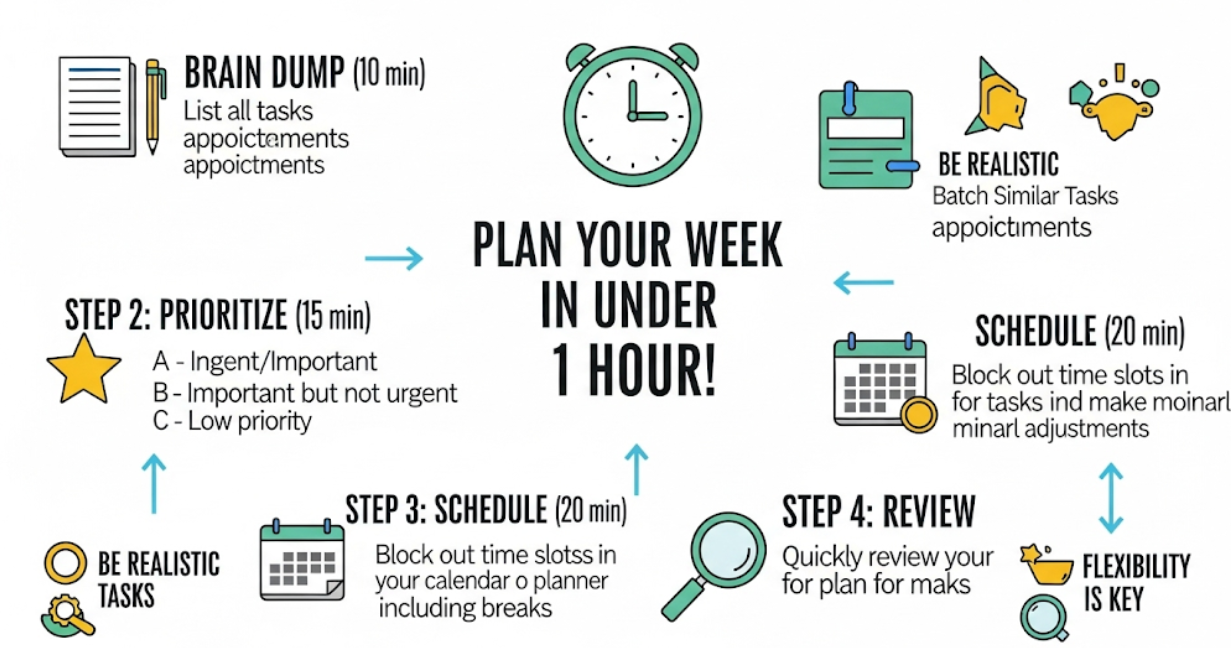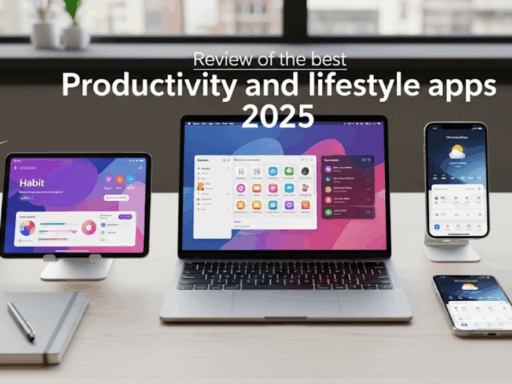The 1-Hour Weekly Planning System That Will Transform Your Life
A few months ago, I came up with a new system that has transformed the way that I plan my week (and it takes ~1 hour)…
That may sound unrealistic to get an entire week worth of planning done in sixty minutes, but that is exactly what I have been doing for the last three years. Easy as that, my whole new approach to time management in order to stress less and do the things.
The biggest tragedy of missing tasks, however, is that most people spend far less time planning their tasks than they worry about them. They create lists describing what they need to do, remember important dates, and have a sense of peace that the list is in perspective. Easy… what if I told you that spending just ONE hour a week actually FIGHTS the chaos!
The gist of weekly planning is nothing but pausing every weekend for less than an hour and the payoff will be multiple hours saved throughout your week (literally) from pointless confusion or stress. In this guide, you will uncover the exact tools that I use and the common pitfalls to avoid as well as how to customize this system for your own lifestyle.
The Reason People are Bad Weekly Planners
But first, let’s explore why most traditional planning methods don’t work for many people.
The most common mistakes I notice are:
- Overplanning — doesn’t stand up to “life”
- Complex systems that are tediously time-consuming to maintain
- Exclusively focusing on work hours and neglecting other things in your life
- Failure to decide on a set time or location for planning
- Over-preparing instead of going with the flow
The reality is planning doesn’t have to be difficult. Because the simpler you make your system, the more likely you are to actually use it.
My 4-Phase Weekly Planning System
Each phase blends with the others to form what becomes my weekly planning methodology in four easy stages. Each phase serves an individual purpose and paves the way for the next one.
Phase 1: The Weekly Review (15 minutes)
This is me reflecting on the week that has passed and what went well, what didn’t and any lessons learned from then.
What I review:
- Done tasks — what did I get accomplished this week?
- Missed deadlines — What did we drop? and Why?
- Time wasters — what caused me to lose focus or spend too much time?
- Wins & Successes — What was working awesome?
- Surprises — What happened that I was not expecting?
I keep this review simple with these three questions:
- What worked well this week?
- What didn’t work and why?
- How will I change my approach next week?
Pro Tip: I write these answers in the notes app on my phone. No fancy journal required.
Phase 2: Brain Dump & Capture (10 minutes)
Then I clear my mind of everything I need to remember for the week ahead. I mean work projects, personal errands, social events and really just random thoughts that have been bouncing around in my head.
My brain dump categories:
- Work tasks and projects
- Personal errands (grocery store, doctor)
- Social obligations (dinners, family stuff etc)
- Home maintenance (cleaning, repairs, organization)
- Health & Fitness (workouts, meal prep)
- Learning — reading, skills, practice, developing myself
Write everything down — without judging or organizing. This is not the time to determine what you think is critical — just to get it all from your head and onto paper (or in your favorite digital tool).
Phase 3: Prioritization & Time Blocking (25 minutes)
This is the core of how I plan. This is how to take a running list and make it into a USEFUL weekly schedule that you can actually follow.
Step 1: Identify the Big 3
The first thing I do is pick the 3 most critical things that I need to get done this week. Not the biggest, but the ones that will have the biggest impact on achieving what I want or will turn into problems if left undone.
Examples of Big 3 items:
- Finish the Johnson project proposal for work
- Complete annual physical exam
- Plan Mom’s birthday celebration
Step 2: Categorize remaining tasks
I sort everything else into categories:
- Must do this week (stuff you have to do this week, like deadlines or appointments)
- Should do this week (high priority but some timing flexibility)
- Could do this week (nice to have but not critical)
- Someday/maybe (ideas for future weeks)
Step 3: Time estimation
I then go through the “must dos” and “should dos,” and realistically estimate how long each will really take me. Experience has taught me to pad the time I estimate, since tasks always take longer than you expect.
Common time estimation mistakes:
- Forgetting email and communication time
- Failing to account for breaks between tasks
- Underestimating research or preparation time
- Ignoring potential interruptions or delays
Step 4: Calendar blocking
Then I open my calendar and schedule time for each of my priority tasks. I work in this order:
- Fixed commitments (meetings, appointments, classes)
- Big 3 tasks (I save the best time slots for these)
- Must-do tasks (filling in the rest of your quality time)
- Should-do tasks (wherever the remaining spots fit)
My time blocking rules:
- Morning (8–11 AM): Deep work + Big 3 tasks
- Afternoon (1-4 PM): Meetings & collaboration hours
- Evening (6-8 PM): Personal tasks and errands
- Leave 25% of time unscheduled for emergencies
Phase 4: Setup & Daily Flexibility Planning (10 minutes)
This is how to set up every day for success while building in realistic flexibility for when things go awry.
For each day, I identify:
- The #1 priority (if I only do one thing, what should it be?)
- Energy requirements (deep work vs. shallow work)
- Potential obstacles (long meetings, traffic, etc.)
- Contingency plans (what if the main plan falls apart)
My daily priority examples:
- Monday: Complete market research for new product launch
- Tuesday: Complete quarterly budget review
- Wednesday: Write and submit project proposal
- Thursday: Conduct team performance reviews
- Friday: Plan for next week, clean up any remaining items
The Tools That Make It All Work
This can be done easily without expensive software or fancy apps. Here are the simple tools I use:
Google Calendar/Apple Calendar
- Why it works: Accessible anywhere, easy to rearrange, built-in reminders
- How I use it: Time blocking, scheduling
- Cost: Free
Apple Notes or Google Keep
- Why it works: Fast capture, searchable, available everywhere
- How I use it: Brain dumps, weekly reviews, random thoughts
- Cost: Free
Simple Task Manager (Todoist, Apple Reminders)
- Why it works: Due dates, priority levels, project organization, satisfying checkoffs
- How I use it: Someday/Maybe list, recurring tasks
- Cost: Free versions available
The key principle: Your tools should help you, not distract you. The simpler, the better.
Customizing the System to Fit Your Lifestyle
This planning method works whether you’re a busy parent, a college student, or a corporate executive. Here are some ways to adapt it for different situations:
For Parents with Young Kids
Modifications needed:
- Plan in 15-minute chunks rather than hours
- Always have backup plans for kid emergencies
- Block family time as non-negotiable calendar blocks
- Create a “quick wins” list for unexpected free moments
Sample Big 3 for parents:
- Arrange babysitter for Friday night date
- Register kids for summer camp
- Finish presentation for Thursday meeting
For College Students
Modifications needed:
- Include study time, assignment deadlines and exam prep
- Balance academic, social and part-time work commitments
- Work around class schedules and campus activities
- Include self-care and mental health activities
Sample Big 3 for students:
- Complete history research paper (due Wednesday)
- Study for chemistry midterm (Friday)
- Apply for summer internship positions
For Remote Workers
Modifications needed:
- Set clear boundaries between work and personal time
- Include workspace setup and breakdown time
- Plan for technology issues and virtual meetings
- Schedule regular breaks and movement throughout the day
Sample Big 3 for remote workers:
- Launch new client onboarding process
- Complete quarterly team training modules
- Organize home office space
For Entrepreneurs and Small Business Owners
Modifications needed:
- Balance urgent client work with long-term strategic thinking
- Include marketing, networking and business development activities
- Plan around irregular income and cash flow
- Block time for regular business review and strategic planning
Sample Big 3 for entrepreneurs:
- Complete Smith Industries project proposal
- Launch email marketing campaign for new service
- Review and adjust business financial projections

Avoiding the Common Mistakes
After using this system for three years and helping hundreds of people set up theirs, I see the same mistakes over and over again. Here’s how to avoid them:
Mistake 1: Planning Every Last Minute
Why it doesn’t work: Life is unpredictable. Over-scheduling makes you feel frustrated when plans don’t go perfectly.
The fix: Only schedule 75% of your available time. Leave buffer time between tasks and block unscheduled time for opportunities or emergencies.
Mistake 2: Making the Big 3 Too Big
Why this fails: If your three priorities are massive projects, you’ll quickly feel like a failure.
The fix: Break them into smaller, achievable goals. For example, go from “Launch new website” to “Write homepage content” or “Choose website color scheme.”
Mistake 3: Not Reviewing and Adjusting
Why this fails: No plan survives contact with reality. Without regular review and adjustment, your system becomes irrelevant.
The fix: Spend 5 minutes every Wednesday to check in on your week and make minor tweaks.
Mistake 4: Perfectionism Paralysis
Why it fails: Waiting for the perfect planning system or the perfect week to start will never happen.
The fix: Start with an imperfect version of this system. You can refine it as you go by learning what works for you.
Mistake 5: Ignoring Energy Levels
Why it fails: Scheduling demanding tasks during your naturally low-energy times leads to frustration and procrastination.
The fix: Notice your energy patterns and plan accordingly. Schedule your most important work during your peak hours.
Why It Works (The Science Behind It)
This planning system isn’t just based on my personal experience — it’s supported by research in psychology about productivity and goal achievement.
The Power of Implementation Intentions
Research by psychologist Peter Gollwitzer shows that people who make specific plans about when and where they will complete tasks are much more likely to follow through. This is called “implementation intention,” and that’s exactly what we’re doing with time-blocking.
The research shows:
- People with specific plans are 2-3 times more likely to achieve their goals
- Time-blocking reduces decision fatigue throughout the week
- It decreases procrastination and increases focus
Cognitive Load Theory
Our brains can only hold so much information at any given time. When we try to remember everything we need to do, we quickly become overwhelmed and less effective. The brain dump phase addresses this by getting everything out of our heads and into an external system.
Benefits of reducing cognitive load:
- Improved focus and concentration
- Better decision-making ability
- Reduced stress and anxiety
- Increased mental energy for creative work
The Zeigarnik Effect
This psychological principle states that unfinished tasks stay active in our minds and create mental pressure. The weekly review process helps close these “mental loops” — either by completing the tasks, scheduling them for a specific time, or consciously deciding to let them go.
Real-Life Results: What to Expect
People often ask what kind of results they should expect when they first start using this system. Here’s what I’ve observed in my own experience and with the hundreds of people I’ve guided through this method:
Week 1-2: The Adjustment Period
- You’ll probably take longer than 60 minutes at first
- Some tasks will take longer than you estimate
- The structure might feel restrictive
- This is normal! Stick with it.
Week 3-4: Finding Your Rhythm
- The planning session starts to feel more natural
- You get better at time estimates
- Less anxiety about forgetting important things
- More clarity about daily priorities
Week 5-8: The Momentum Builds
- Planning consistently takes less than an hour
- You start completing your Big 3 regularly
- Family, friends and coworkers notice you seem more organized
- You feel more in control of your time
Week 9+: Long-term Benefits
- Significant reduction in stress and overwhelm
- Better work-life balance
- More time for meaningful relationships and hobbies
- Increased confidence in handling challenges
Advanced Tips for Power Users
Once you’ve mastered the basics, here are some advanced strategies to take your planning to the next level:
Theme Your Days
Assign different types of work to different days of the week. For example:
- Monday: Strategic planning and big picture thinking
- Tuesday: Client meetings and external communications
- Wednesday: Administrative tasks and email processing
- Thursday: Creative work and skill development
- Friday: Catch-up time, planning, and networking
Use the “2-Minute Rule”
If something takes less than 2 minutes to complete, don’t add it to your planning system — just do it immediately during your brain dump. This prevents tiny tasks from cluttering your planning system.
Batch Similar Activities
Reduce context switching by grouping similar tasks together. For example:
- Dedicate one hour to all phone calls
- Complete all errands in one trip
- Process email at specific times of day
Create Standard Weekly Templates
As you notice recurring weekly patterns, create templates. For example, if you teach fitness classes on Tuesdays and Thursdays or have team meetings every Monday, build these into a template you can use as the starting point for your weekly schedule.
Track Your Planning Accuracy
Keep a simple log of how accurate your time estimates are. Over time, you’ll get better at understanding how long things really take, making your planning more realistic and achievable.
Troubleshooting Common Problems
Even with a great system, you’ll have challenging moments. Here are the most common problems and solutions:
“I never have a full hour to plan”
Solution: Break the planning session into smaller chunks throughout the week:
- 15 min Sunday evening: Weekly review
- 15 min Monday morning: Brain dump
- 15 min Tuesday: Priority setting
- 15 min Wednesday: Mid-week adjustment
“My week never goes according to plan”
Solution: This is actually normal! The goal isn’t perfect execution — it’s having a framework to make better decisions when things change. Focus on completing your Big 3, and be flexible with everything else.
“I keep forgetting to do my weekly planning”
Solution: Attach your planning session to something you already do consistently. For example:
- Right after Sunday morning coffee
- Before your Monday morning workout
- After your Friday afternoon work wrap-up
“I get overwhelmed during brain dump”
Solution: Set a timer for 10 minutes, and stop when it goes off, even if you haven’t captured everything. Remember, you can always add things to the list as you think of them throughout the week.
“My priorities seem to shift every day”
Solution: This is why we do the Wednesday check-in! However, it’s fine to reorder your Big 3 if circumstances truly change — just make sure you’re not moving things around due to avoidance rather than genuine reprioritization.
Making the System Stick Long-Term
Learning this system isn’t the hard part — sticking with it for months and years is. Here are the strategies that help my system survive long-term:
Start Small and Build Gradually
Don’t try to implement every part of this system at once. Start with just the brain dump and Big 3 identification. Add time blocking after a week or two, and incorporate the other elements as they become natural.
Track Your Wins
Write down one thing each week that you accomplished because of your planning. When you start to doubt whether it’s working, you’ll have concrete evidence of your progress.
Adjust for Seasons
Your planning needs will vary throughout the year. During busy seasons (like year-end at work or back-to-school time) focus heavily on your must-dos. During slower periods, challenge yourself to tackle should-do and could-do tasks.
Find an Accountability Partner
Share your weekly Big 3 with a friend, family member, or coworker. When someone else knows what’s a priority for you, it provides gentle accountability and makes you much more likely to follow through.
Celebrate Your Progress
Acknowledge when you complete your Big 3 or stick to your planning routine for several weeks straight. Small celebrations reinforce the habit and build momentum for continued success.
Conclusion: Your Next Steps
Planning your entire week in under an hour might seem like magic, but it’s actually a skill that becomes easier with practice. This system isn’t perfect, but it’s a practical framework that can help you live more intentionally and productively.
Start small, then adjust based on what works best for your unique situation. Begin today — don’t wait for the perfect moment or the perfect week. Choose a time this weekend, set a 60-minute timer, and work through the four phases I’ve outlined above.
Remember, the goal isn’t to control every moment of your week — it’s to enter your week with confidence that you’re focusing on what matters most and making progress on your most important goals.
One hour invested today will pay dividends all week long, and your future self will thank you for it. Who knows? This simple practice might just become the most valuable hour of your entire week.
Ready to get started? Grab your simple tools (a calendar and notes app) and commit to testing this system for just four weeks. That’s all you need to see the impact it can have on your productivity and peace of mind.
The best time to plan your week was last Sunday. The second best time is right now.




